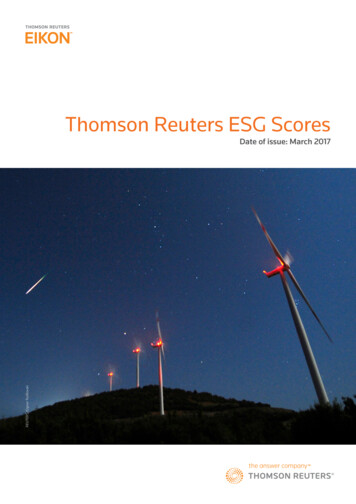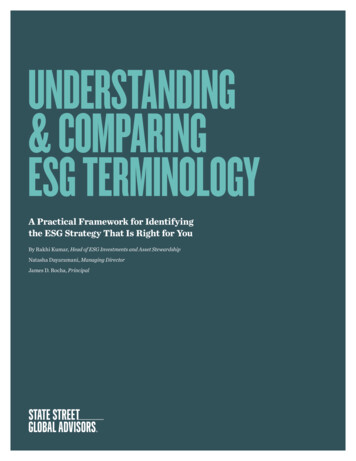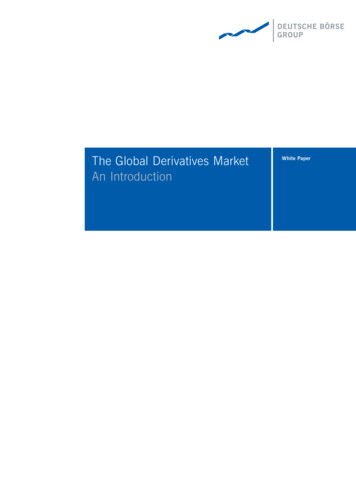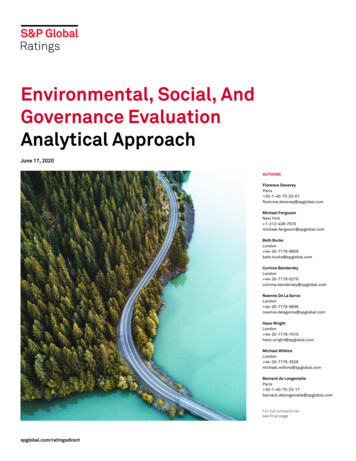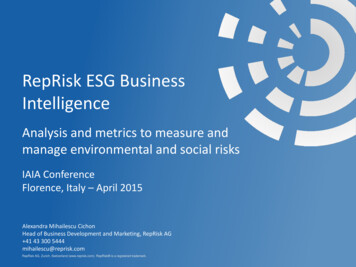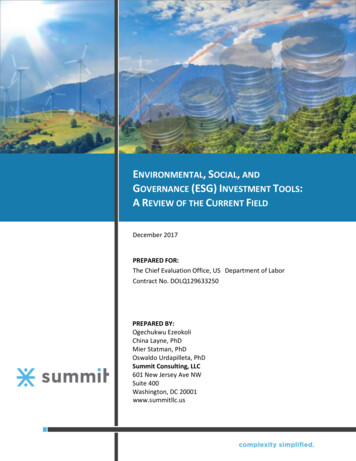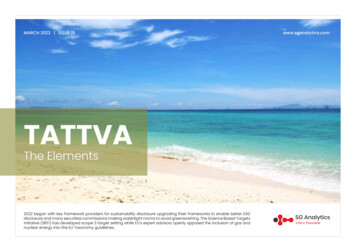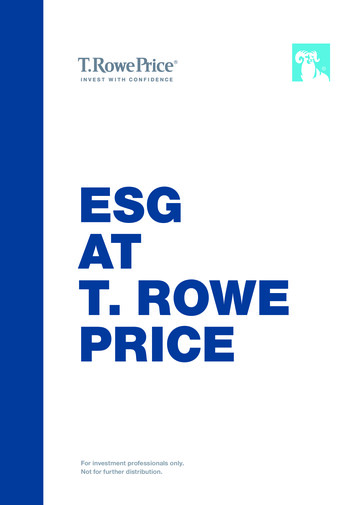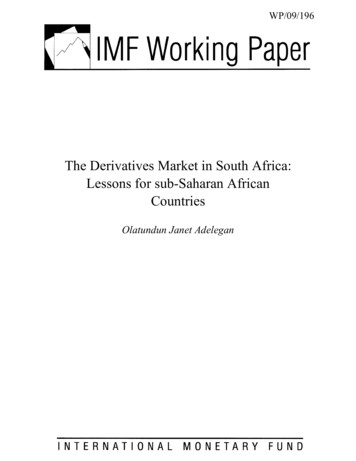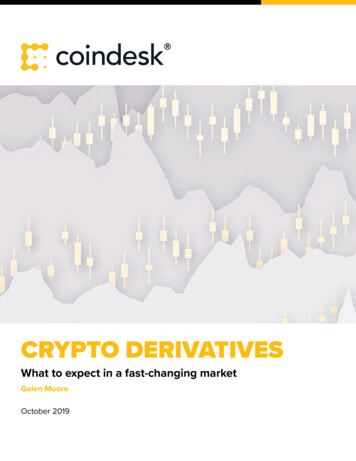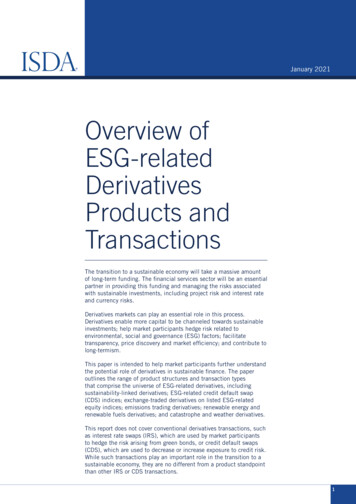
Transcription
January 2021Overview ofESG-relatedDerivativesProducts andTransactionsThe transition to a sustainable economy will take a massive amountof long-term funding. The financial services sector will be an essentialpartner in providing this funding and managing the risks associatedwith sustainable investments, including project risk and interest rateand currency risks.Derivatives markets can play an essential role in this process.Derivatives enable more capital to be channeled towards sustainableinvestments; help market participants hedge risk related toenvironmental, social and governance (ESG) factors; facilitatetransparency, price discovery and market efficiency; and contribute tolong-termism.This paper is intended to help market participants further understandthe potential role of derivatives in sustainable finance. The paperoutlines the range of product structures and transaction typesthat comprise the universe of ESG-related derivatives, includingsustainability-linked derivatives; ESG-related credit default swap(CDS) indices; exchange-traded derivatives on listed ESG-relatedequity indices; emissions trading derivatives; renewable energy andrenewable fuels derivatives; and catastrophe and weather derivatives.This report does not cover conventional derivatives transactions, suchas interest rate swaps (IRS), which are used by market participantsto hedge the risk arising from green bonds, or credit default swaps(CDS), which are used to decrease or increase exposure to credit risk.While such transactions play an important role in the transition to asustainable economy, they are no different from a product standpointthan other IRS or CDS transactions.1
Overview of ESG-related Derivatives Products and TransactionsEXECUTIVE SUMMARYAs the costs and challenges of climate change continue to mount, so too has the need to mobilize capitalto drive climate innovation. The financial services sector will be an essential partner in meeting this need,by providing funding and managing the risks associated with sustainable investments, including projectrisk and interest rate and currency risks.Customers are searching for climate mitigation strategies and new ESG-related products, whether forinvestment or financing purposes. To avoid greenwashing and ensure a high level of trust and expectedoutcomes, the financial service industry needs to develop globally consistent ESG standards, best practicesand taxonomies to ensure investment products are consistent and verifiably accurate in terms of deliveringsustainable and socially responsible outcomes.Derivatives markets can play an essential role in facilitating the transition to a sustainable economy. Asnoted in a recent research report by the Centre for European Policy Studies (CEPS) and the EuropeanCapital Markets Institute (ECMI), derivatives enable more capital to be channeled towards sustainableinvestments1; help market participants hedge risk related to ESG factors; facilitate transparency, pricediscovery and market efficiency; and contribute to long-termism2.This paper builds on the CEPS-ECMI report and is intended to help market participants furtherunderstand the potential role of derivatives in sustainable finance. The paper outlines the range ofproduct structures and transaction types that comprise the universe of ESG-related derivatives, includingsustainability-linked derivatives; ESG-related CDS indices; exchange-traded derivatives on listed ESGrelated equity indices; emissions trading derivatives; renewable energy and renewable fuels derivatives;and catastrophe and weather derivatives. Descriptions and examples of each of these transaction types areprovided in the following pages.This report does not cover conventional IRS, which are used by market participants to hedge the riskarising from green bonds, or conventional CDS, which are used to decrease or increase exposure to creditrisk. While such transactions play an important role in the transition to a sustainable economy, they are nodifferent from a product standpoint than other IRS or CDS transactions.Continuing innovations in the market make it very challenging to compile a list of product structures thatis entirely comprehensive. ISDA will continue to monitor market developments to update this paper infuture months.Derivatives are essential to the European Union’s (EU) Sustainable Europe Investment Plan (SEIP), the investment pillar of the EU Green Deal, which isset to mobilize at least 1 trillion in sustainable investments over the next decade2 Derivatives in Sustainable Finance, Centre for European Policy Studies (CEPS) and the European Capital Markets Institute (ECMI): nable-Finance.pdf. ISDA provided sponsorship for this report1 2
Overview of ESG-related Derivatives Products and TransactionsSUSTAINABILITY-LINKED DERIVATIVESA range of sustainability-linked derivatives has been issued over the past several years, which add anESG pricing component to conventional hedging instruments, such as IRS, cross-currency swaps orforwards3. These transactions are highly customizable and use various key performance indicators (KPIs)to determine sustainability goals.Some of the transactions can reduce one counterparty’s payment in the event it achieves some pre-agreedsustainability performance target. This mechanism provides market participants with a financial incentivefor improved ESG performance. Other transactions facilitate the clients’ ability to support sustainabilityoutcomes through a derivatives transaction. If a company cannot meet its ESG target, it will have tocompensate by supporting climate action sustainability projects.Table 1 provides examples of recently issued sustainability-linked derivatives, which focus on individualclient approaches to sustainability. As this is a niche, nascent market, the transaction volume has been verylow, and uptake is expected to be gradual.Table 1: Sustainability-linked IRS and Foreign Exchange (FX) Derivatives4IssuerDeal InformationSustainability-linked CharacteristicsInterest Rate DerivativesSBM Offshore, a global supplier of floatingproduction solutions to the offshore energyindustryIn August 2019, ING executed the world’s firstsustainability improvement derivative (SID),designed to hedge the interest rate risk of SBM’s 1 billion five-year floating rate revolving creditfacility. SBM pays a fixed rate on the swap andreceives a floating rate5.The SID adds a positive or negative spread tothe fixed rate set at the inception of the swapbased on SBM’s environmental, social andgovernance (ESG) performance, which is scoredby Sustainalytics.Italo - Nuovo Trasporto Viaggiatori, a private railoperatorIn January 2020, Natixis structured a 1.1 billionsustainability-linked syndicated loan. The loancomprised a 200 million revolving credit facilityto provide general corporate funding and a 900million green loan to finance and refinance thecompany’s low-carbon rolling stock6.As part of the loan transaction, the companyalso executed a sustainability-linked interestrate swap (IRS) that included an incentivemechanism aligned with the sustainableperformance indicators outlined in the financingagreement.Siemens Gamesa, a supplier of wind powersolutionsIn March 2020, HSBC executed an IRS thatconverted a 250 million tranche of a floatingrate syndicated loan, which was arranged inDecember 2019, into fixed-rate funding7.The fixed rate of the swap will not vary ifSiemens Gamesa’s ESG rating changes, but anychange during the life of the swap will promptcharitable giving. If Siemens Gamesa’s ESGrating improves, HSBC will donate annually toprojects of non-profit organizations. If the ratingdeclines, Siemens Gamesa will donate. Thisincentive structure differs from some other ESGlinked derivatives hedges where the ESG targetimpacts the cost of the hedge.At the beginning of every year during the life ofthe swap, ING sets a target ESG score for SBM.If this score has been met, a discount of 5-10basis points (bp) is applied to the fixed rate paidby SBM. If SBM hasn’t met its targeted ESGscore, it has to pay a 5-10bp penalty.Continued on next page Scaling Finance for the Sustainable Development Goals 1/Scaling-SDG-Finance.pdfThis list of derivatives transactions is not comprehensive. The examples of over-the-counter (OTC) derivatives transactions are based on publiclyavailable information5 Introducing the world’s first sustainability improvement derivative htm6 Natixis Structures an Innovative Financing Solution for Italo - Nuovo Trasporto Viaggiatori, Aligned with the Company’s Sustainable DevelopmentTargets 7 Siemens Gamesa in ESG-linked interest rate swap -swap/74587038#: :text terest%20rate%20risk3 4 3
Overview of ESG-related Derivatives Products and Transactions Continued from previous pageIssuerDeal InformationSustainability-linked CharacteristicsInterest Rate DerivativesGoodman Interlink Limited, a global logisticsproperty groupIn November 2020, Credit Agricole CIBexecuted a green IRS, totaling HK 590 million 8.A preferential fixed rate paid by the borrowerwas linked to the underlying facility’s greenclassification. The company’s fixed rate stepsup to non-preferential if the green condition fails.The green condition is satisfied if the companymaintains two requirements: (1) silvercertification from the US Leadership in Energyand Environmental Design, the most widelyused green building rating system in theworld; and (2) gold certification of the buildingenvironmental assessment method (BEAM)from the BEAM Society Limited, an organizationspecializing in green certification for Hong Kongbuildings.New World Development, a real-estate ownerand developerIn November 2020, DBS Hong Kong completedan IRS linked to the United Nations SustainableDevelopment Goals (UNSDGs). This derivativetransaction is designed to provide a hedgeagainst the interest rate risk related to the NewWorld Development (NWD) five-year HK 1 billionsustainability-linked loan from DBS, which closedin November 2019 9.If the company successfully generates atleast eight business-to-business integrationopportunities that contribute to the UNSDGsadopted by the New World Sustainability Vision2030, it is eligible to receive sponsorship fromDBS to support social innovation projects.NWD’s social innovation initiatives includeImpact Kommons, a UNSDG-focused start-upaccelerator and business-integration program, ofwhich DBS is a social impact partner.FX DerivativesEnel, an Italian power and gas companyIn September 2019, Société Générale executeda sustainable-development-goal-linked crosscurrency swap tied to a 1.5 billion bond. Theswap enables Enel to hedge its exposure againstthe euro/dollar exchange rate and interest raterisk created by the different denomination of thebond repayments (US dollars) and the source ofrepayments (euros)10.As part of the transaction, Enel received adiscounted rate based on its commitment tosustainability performance. Société Généraleprovided the discount as part of its commitmentto the positive impact finance and basedon Enel’s positive contribution to one of thepillars of sustainable development (economic,environmental and social) and mitigation of anypotential negative impacts to any of the pillars.Enel’s bond is linked to the company’s abilityto increase its installed renewable electricitygeneration capacity from 45.9% to 55% byDecember 2021. Should Enel not be able toachieve this objective, the interest on the bondwill rise by 25bp to 2.9%. This will be carriedover to the accompanying cross-currency swap,which will be rebooked if the bond couponchanges.Continued on next page Credit Agricole CIB innovates, bringing the first green interest rate swaps to the Asia-Pacific capital markets te-swaps-asia-pacific9 New World Development Joins Forces with DBS Hong Kong to Pioneer Hong Kong’s First Interest Rate Swap Linked to the United Nations SustainableDevelopment Goals %80%99s-firstinterest-rate10 Enel Electrifies Sustainability Market with Inaugural Green-linked Bond and Swap inaugural-green-linked-bond-and-swap/8 4
Overview of ESG-related Derivatives Products and Transactions Continued from previous pageIssuerDeal InformationSustainability-linked CharacteristicsFX DerivativesSiemens Gamesa, a supplier of wind powersolutionsOlam International, a major food and agribusiness companyPrimetals Technologies, an engineering andplant construction companyIn October 2019, BNP Paribas executed a 174million FX hedging contract. The transactionaims to hedge Siemens Gamesa’s FX exposurefrom selling offshore wind turbines in Taiwanand to contribute to the UNSDG targets relatedto climate action and affordable and cleanenergy11.Depending on whether Siemens Gamesareaches its sustainability targets, BNP Paribaswill reinvest any premium into reforestationprojects.In June 2020, Deutsche Bank executed anFX derivative linked to ESG key performanceindicators (KPIs). A one-year US dollar/Thai bahtFX forward enables Olam to hedge its FX riskarising from exporting agriculture products fromfarms in Thailand to the rest of world12.The transaction allows Olam International to lockin a discount when it meets pre-defined ESGtargets, which support the UNSDGs.In October 2020, Deutsche Bank entered intoan FX transaction that links currency optionsto sustainability goals. This agreement enablesPrimetals Technologies to hedge its currency riskwith FX options over a four-year period13.If Primetals Technologies fails to meet theagreed sustainability targets, it must pay apredefined sum to a contractually defined nongovernmental organization.If Siemens Gamesa misses its annual minimumESG score, it must pay a sustainability premium,which BNP Paribas will reinvest in reforestationprojects. The premium is calculated usinga metric assigned by third-party sustainablefinance specialists RobecoSAM.The transaction KPIs will contribute to 10 ofthe 17 UNSDGs, including alleviating poverty(UNSDG 1); alleviating hunger (UNSDG 2);improving gender quality (UNSDG 5); improvingclean water and sanitation (UNSDG 6); reducinginequalities (UNSGD 10); increasing responsibleconsumption and production (UNSDG 12);contributing to climate action (UNSDG 13);protecting life below water (UNSGD 14);protecting life on land (UNSGD 15); andincreasing partnerships for the goals (UNSDG17).The currency hedge is linked to severalsustainability targets, including the proportionof total sales of projects that aim to reducegreenhouse gas emissions for customers, andrevenues relative to research and developmentexpenditure that result in improved resourceefficiency. Another metric is the promotion of asafe and healthy work environment for all staff atPrimetals Technologies.Independent consultants will monitor and certifywhether the targets are adhered to for the entirelife of the option.Continued on next page Siemens Gamesa Pioneers the Green Foreign Exchange Hedging Market e-siemens-gamesa-green-fx-en.pdf12 Deutsche Bank Executes Asia’s First FX ESG Derivative s-asias-first-fx-esg-derivative/13 Deutsche Bank draws up the world’s first ESG FX derivative framework agreement for Primetals Technologies 9.htm11 5
Overview of ESG-related Derivatives Products and Transactions Continued from previous pageIssuerDeal InformationSustainability-linked CharacteristicsFX DerivativesHysan Development, a Hong Kong propertydeveloperIn October 2020, BNP Paribas executed a 125million approximately15-year sustainabilitylinked hedge14.Under the terms of the transaction, Hysancommits to remain as a constituent memberof the Hang Seng Corporate SustainabilityBenchmark Index, which ranks the top 20%of Hong Kong companies based on theirsustainability performance on broad metrics, forthe period between 2021-2024. The companyalso commits to reduce its energy consumptionby 20% by December 31, 2024.If Hysan is not successful in reaching the twogoals, it will contribute to an impact-drivencharity approved by BNP Paribas.Enel, an Italian power and gas companyIn October 2020, Enel issued 500 million ofsustainability-linked bonds. Along with thisissuance, Enel also executed a sustainabilitylinked cross-currency swap with JP MorganChase to hedge against the sterling/euroexchange rate and interest rate risk15.The bonds are linked to the company’s abilityto reach at least 60% renewable generationwithin its total installed capacity by December31, 2022. The achievement of the target willbe certified by an auditor’s specific assurancereport16.The interest rate on the bonds will remainunchanged to maturity, unless Enel fails toachieve the sustainability performance target. Ifthe target is not achieved, a step-up mechanismwill be applied, increasing the rate by 25bp asof the first interest period after publication of theassurance report of the auditor.Enel and JPMorgan will pay interest to eachother on the borrowed money every six monthson the cross-currency swap. That interest costcan rise if either side does not keep up to itsenvironmentally friendly targets17.JP Morgan has pledged to help arrange 200billion of funding this year for climate-changeaction and the UNSDGs, which include activitiessuch as underwriting green bonds.Hysan Unveils Innovative Green Hedging Solution nveils-innovative-green-hedging-solutionEnel issues 500 million of sustainability-linked bond 0m-of-sustainability-linked-bond-6072526716 Enel issues 500 million of sustainability-linked bond 0m-of-sustainability-linked-bond-6072526717 JPMorgan Currency Deal Highlights Finance’s Green Shift l-highlights-finances-greenshift-1160372783814 15 6
Overview of ESG-related Derivatives Products and TransactionsESG-RELATED CREDIT DERIVATIVESMarket participants can use CDS18 to manage the credit risk of a counterparty or credit where its financialresults may suffer because of climate change or where its viability might be threatened. In that respect,CDS can serve two different purposes: i) to hedge future potential losses that would be realized followingthe occurrence of a catastrophic event (that leads to bankruptcies/defaults); and ii) to hedge the risk ofchanges in the market value of ESG/sustainability-linked bonds/loans resulting from market expectationsof future potential losses/damages and other market factors19.ESG screening can be applied to the reference entities of CDS contracts. A growing body of researchsuggests that companies with high ESG ratings exhibit lower credit risk20. Companies that perform wellagainst ESG metrics are increasingly recognized as potentially offering higher returns and representinglower risk than firms without these goals.In May 2020, IHS Markit launched the iTraxx MSCI ESG Screened Europe Index, which is a broadEuropean corporate CDS index derived using ESG criteria. The index includes a basket of CDS contractson companies that meet various sectoral, controversy and ESG risk criteria. It follows a three-stepscreening methodology based on MSCI ESG research, including a value-based screen, a controversy-basedscreen and an ESG-ratings-based screen21. The index started trading from June 2020 at the five-year tenor.Being a broad sector-diversified index, the iTraxx MSCI ESG Screened Europe Index can be used asa macro instrument to gain exposure to or hedge broad ESG European corporate risk. Due to thesimilarities in the ESG screening methodology applied to the iBoxx bond indices, the iTraxx MSCI ESGScreened Europe Index could also be an effective hedge for bond portfolios tracking forthcoming iBoxxMSCI ESG indices.The iTraxx MSCI ESG Screened Europe Index can also be used by buy-side firms that want to gain longexposure (protection seller position) to ESG companies. The similarities and high correlation of the indexwith the overall iTraxx Europe Index allows sell-side trading counterparties to use the iTraxx Europe Indexto hedge their protection buyer positions 22.LCH CDSClear started clearing the iTraxx MSCI ESG Screened Europe Index and its constituent singlenames for members and their clients in September 2020. In addition to managing counterparty risk,clearing also encourages greater liquidity in this product, provides significant margin and operationalbenefits and supports the wider industry focus on sustainability 23.A credit default swap (CDS) is a type of derivative that transfers the risk of certain defaults of a particular borrower (the ‘reference entity’) referenced inthe CDS contract (eg, a financial, corporate or sovereign entity), from the buyer to the seller. The buyer makes periodic payments to the seller and inreturn receives a settlement upon the occurrence of a default (a credit event) with respect to the referenced entity19 Derivatives in Sustainable Finance, CEPS ECMI Study, Centre for European Policy Studies nableFinance.pdf ISDA provided sponsorship for this report20 Foundations of ESG Investing in Corporate Bonds -Affects-Corporate-Credit-Risk-and-Performance (002).pdf21 iTraxx MSCI ESG Screened Europe Index Rules ementsFile?CMSID 1a9f39ab4d774f94aecfa46f2a0443e322 First of its kind ESG Index - iTraxx MSCI ESG Screened Europe Index i-esg-screened-europe-index.html23CDSClear Goes Live Clearing New ESG Index Series earing-new-esg-index-series/18 7
Overview of ESG-related Derivatives Products and TransactionsESG-RELATED EXCHANGE-TRADED DERIVATIVESWith more capital flowing into ESG strategies, global exchanges, including Eurex, IntercontinentalExchange (ICE), CME Group, Nasdaq, Chicago Board Options Exchange (CBOE), Euronext and JapanExchange Group, have recently launched a series of new equity index futures and options contracts tied toESG benchmarks. While liquidity in most of these new contracts is still relatively low, demand has beengradually increasing.ESG futures and options enable institutional managers to better hedge their ESG investments, moreefficiently implement their ESG investment strategies, and better manage cash inflows and outflows oftheir ESG funds. Using ESG futures and options allows funds to meet target allocation in a more cashefficient way than investing directly in the underlying stocks.ESG index derivatives reference ESG indices, which are based on parent benchmarks that define theuniverse of companies from which the constituents of an ESG index are selected.ESG indices can be based on an exclusion methodology that allows investors to eliminate certain typesof exposures, while retaining similar risk-return characteristics to the parent benchmark. Some examplesof exclusions are companies considered to be non-compliant with certain ESG standards or companiesinvolved in controversial weapons, tobacco or fossil fuels. Alternatively, ESG indices can be constructed togain exposure to high ESG ratings, a specific ESG theme, or to generate a positive environmental or socialimpact. ESG indexes may combine elements of these approaches.Examples of ESG futures and options launched by major exchanges include 24: CME E-mini S&P 500 ESG Index futuresCBOE S&P 500 ESG Index optionsEurex STOXX Europe 600 ESG-X Index futures / optionsEurex STOXX USA 500 ESG-X Index futuresEurex EURO STOXX 50 Low Carbon Index futuresEurex STOXX Europe Climate Impact Ex Global Compact Controversial Weapons & Tobacco Index futuresEurex STOXX Europe ESG Leaders Select 30 Index futures / optionsEurex DAX 50 ESG futures / optionsEurex EURO STOXX 50 ESG Index futures / optionsICE MSCI EAFE ESG Leaders Index futuresICE MSCI Emerging Markets ESG Leaders Index futuresICE MSCI Europe ESG Leaders Index futuresICE MSCI Japan ESG Select Leaders Index futuresICE MSCI World ESG Leaders Index futuresICE MSCI World Climate Change futuresICE MSCI Europe Climate Change futuresPlease note this list is not exhaustive24 8
Overview of ESG-related Derivatives Products and TransactionsEMISSIONS TRADINGEmissions trading, which can also be referred to as cap and trade, emissions trading schemes or allowancetrading, is a market-based approach to reducing pollution. It is designed to set a geographic limit on the amountof (primarily) carbon dioxide that can be emitted into the atmosphere by specific sectors of the economy.Emissions trading includes two key components: a limit (or cap) on pollution and tradable allowances thatauthorize allowance holders to emit a specific quantity (eg, one ton) of the pollutant25. The limit declineson an annual basis, with the intention of reducing the overall amount of emissions.Market participants can trade emission allowances (including offset credits) and derivatives based onemission allowances (primarily futures and options). Emission allowances can be purchased throughcentrally organized auctions or from other companies that have more than they need for compliance.Secondary trading can be executed on exchanges or in over-the-counter (OTC) markets as spot, forwards,futures and options contracts.While trading on exchanges provides more liquidity, OTC transactions provide greater flexibility ascontracts can be customized more precisely to a company’s particular risk management needs.Market participants use ISDA templates for emission allowances (ie, the ISDA US Emissions Annex and the ISDAEU Emissions Annex) to trade swaps, options and forwards. ISDA also offers EU emissions forms for the tradingof carbon dioxide allowances. The ISDA US Emissions Annex covers sulfur dioxide and nitrogen oxide emissions(under the federal scheme) and carbon dioxide (under the Regional Greenhouse Gas Initiative scheme).Derivatives based on carbon allowances and carbon offsets enable companies subject to carbon cap-and-tradeprograms to meet obligations and manage their risk in a cost-effective way. Policy makers rely on price signalsfrom these instruments to gauge the effectiveness of their programs and ensure desired outcomes26.Carbon markets exist as mandatory (compliance) schemes and as voluntary programs. Compliance carbonmarkets are created and regulated by mandatory national, regional or international carbon reductionregimes. Cap-and-trade programs are set on a national or regional level. Depending on the program,allowances can either be allocated to regulated polluters for free or are bought at an auction.To comply with a specific cap-and-trade program, a company must either keep its emissions within theallowable annual limit or purchase additional allowances. Each year, companies must surrender enoughallowances to cover all their emissions, otherwise heavy fines are imposed. If a company reduces itsemissions below the limit, it can keep the spare allowances to cover its future needs or sell them to anothercompany that is short of allowances27.The voluntary carbon markets function outside of compliance markets and enable individuals, companiesor governments to purchase carbon offsets on a voluntary basis. The majority of voluntary credits arepurchased by the private sector, where corporate social responsibility goals are typically the key drivers.In September 2020, a private-sector-led taskforce was launched to begin scaling voluntary carbonmarkets to help reduce emissions. This initiative involves more than 40 leaders from six continents withbackgrounds across the carbon market value chain28.One of the recommendations of the taskforce for creating a voluntary carbon market is to create carbonspot and futures contracts, with the aim of matching suppliers’ products and buyers’ preferences moreefficiently. Critically, this would provide a daily reference carbon price for a standardized product29.What Is Emissions Trading? at-emissions-tradingEnvironmental markets and indices https://www.theice.com/energy/environmental27 In some schemes, companies that do not pollute (and therefore have no obligations) may also trade permits and financial derivatives of permits28 Private Sector Voluntary Carbon Markets Taskforce Established to Help Meet Climate Goals untary Carbon Markets: A Blueprint tary-carbon-markets-blueprint25 26 9
Overview of ESG-related Derivatives Produc
with sustainable investments, including project risk and interest rate and currency risks. Derivatives markets can play an essential role in this process. Derivatives enable more capital to be channeled towards sustainable investments; help market participants hedge risk related to
